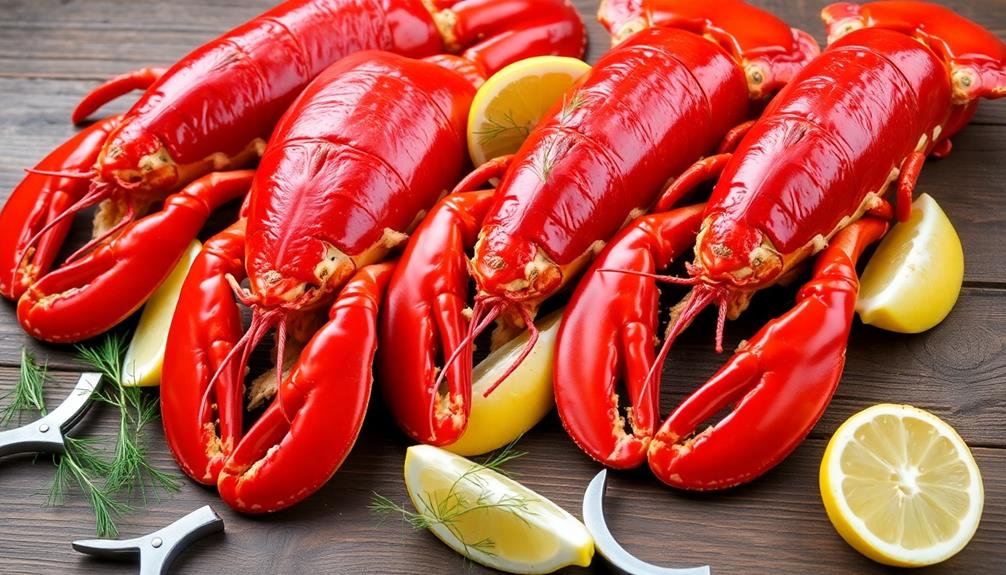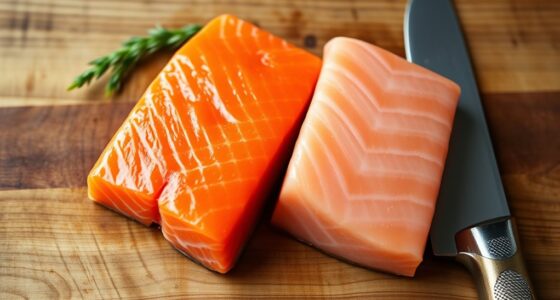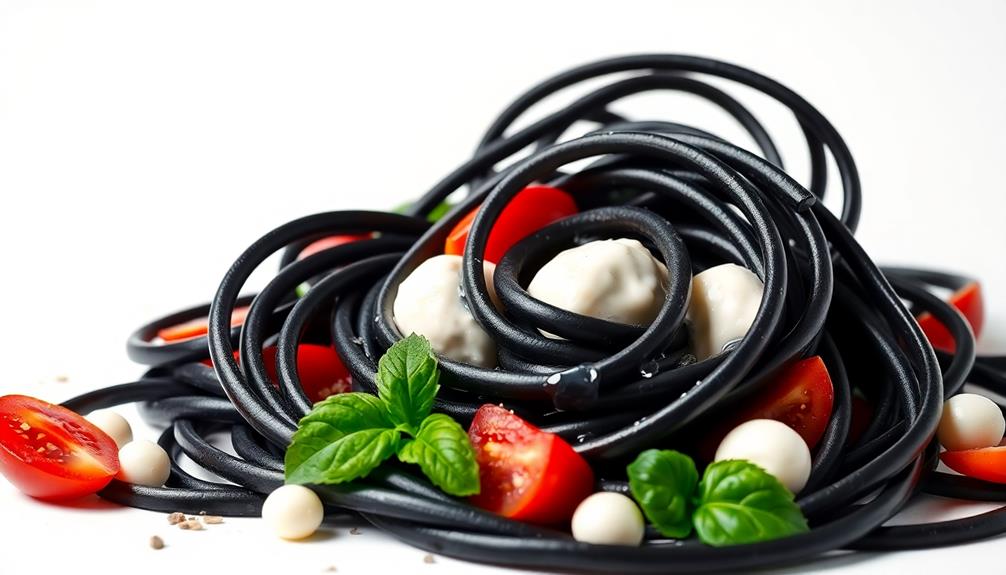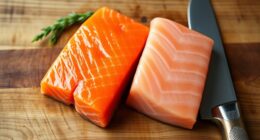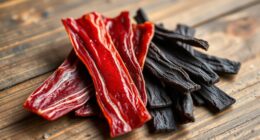Lobsters have come a long way from their humble roots as "poor man's food"! Today, these incredible crustaceans are the "king" of the seafood world. Start by picking lively, hard-shelled lobsters – the freshest you can find. Next, crack open that shell with a nutcracker and gently remove the sweet, tender meat. You can boil, steam, grill, or bake your lobster to perfection. For an extra-special dish, try the classic Lobster Thermidor, where the meat is baked in a creamy, cheesy sauce. Savor lobster's rich, buttery flavor and tender texture – it's a delicacy that's sure to impress. But that's just the beginning – let's dive deeper into the world of this amazing seafood!
Key Takeaways
- Lobsters have a rich history, evolving from poor man's food to a symbol of wealth and a highly sought-after delicacy worldwide.
- When buying lobsters, look for lively and active ones with hard shells, and consider size and sustainable sourcing for optimal quality and flavor.
- Cooking methods like boiling, steaming, grilling, and baking can enhance the tender and sweet flavor of lobster meat, which should be cooked to an internal temperature of 145°F.
- Lobster Thermidor, a classic dish featuring lobster baked in a creamy, cheese-based sauce, exemplifies the rich and decadent flavor profile of this king of crustaceans.
- Lobster is a healthy seafood option, low in calories but high in protein, omega-3 fatty acids, vitamins, and minerals, making it a nutritious delicacy.
History
Lobsters have captivated human imagination for centuries. These remarkable crustaceans have a long and fascinating history, dating back thousands of years.
In ancient times, lobsters were so plentiful that they were often used as fertilizer or animal feed. Imagine that! Back then, these sea creatures were considered a poor man's food, not the delicacy they're known as today.
As time passed, lobsters grew in popularity, becoming a symbol of wealth and prestige. The wealthy and powerful began serving lobster at their lavish feasts, showcasing their affluence.
Interestingly, lobsters were even used as a form of currency in some parts of the world. Can you picture using these amazing creatures to pay for goods and services?
Today, lobsters remain a highly sought-after delicacy, enjoyed by people all over the globe. Their rich history and captivating story continue to fascinate us, making them the true "king of crustaceans."
Recipe
Lobster is a delectable and luxurious seafood that can be prepared in a variety of ways. One classic preparation is to simply boil or steam the lobster and serve it with drawn butter or a lemon wedge.
However, for those looking to elevate their lobster experience, a flavorful recipe is a must-try.
This recipe for Lobster Thermidor is a rich and indulgent dish that showcases the natural sweetness of the lobster meat. The lobster is baked in a creamy, cheese-based sauce, then returned to the shell for a truly impressive presentation.
Ingredients:
- 2 live lobsters (1-1.5 lbs each)
- 4 tbsp unsalted butter
- 1/4 cup brandy
- 1/2 cup heavy cream
- 1/2 cup grated Gruyère cheese
- 2 tbsp fresh parsley, chopped
- 1 tsp Dijon mustard
- Salt and pepper to taste
Instructions:
Bring a large pot of salted water to a boil. Add the lobsters and cook for 8-10 minutes, until the shells turn bright red. Remove the lobsters from the pot and let cool.
Crack the shells and remove the meat in one piece. Chop the lobster meat into bite-sized pieces.
In a skillet, melt the butter over medium heat. Add the brandy and cook for 1 minute. Stir in the heavy cream, Gruyère, parsley, and Dijon mustard. Season with salt and pepper.
Add the chopped lobster meat and stir to coat. Spoon the mixture back into the lobster shells.
Bake the stuffed lobsters at 375°F for 15-20 minutes, until the cheese is melted and bubbly. Serve immediately, garnished with additional parsley if desired.
When preparing this dish, be sure to use fresh, high-quality lobster for the best flavor and texture. The creamy, cheesy sauce pairs perfectly with the sweet lobster meat, making this a truly indulgent and impressive meal.
Cooking Steps
Selecting the perfect live lobster is key.
Use a nutcracker to easily crack the shell and retrieve the delicious meat.
Once you've removed the meat, be sure to devein and rinse it thoroughly before cooking to enjoy the freshest, most flavorful lobster.
Step 1. Select Live Lobster
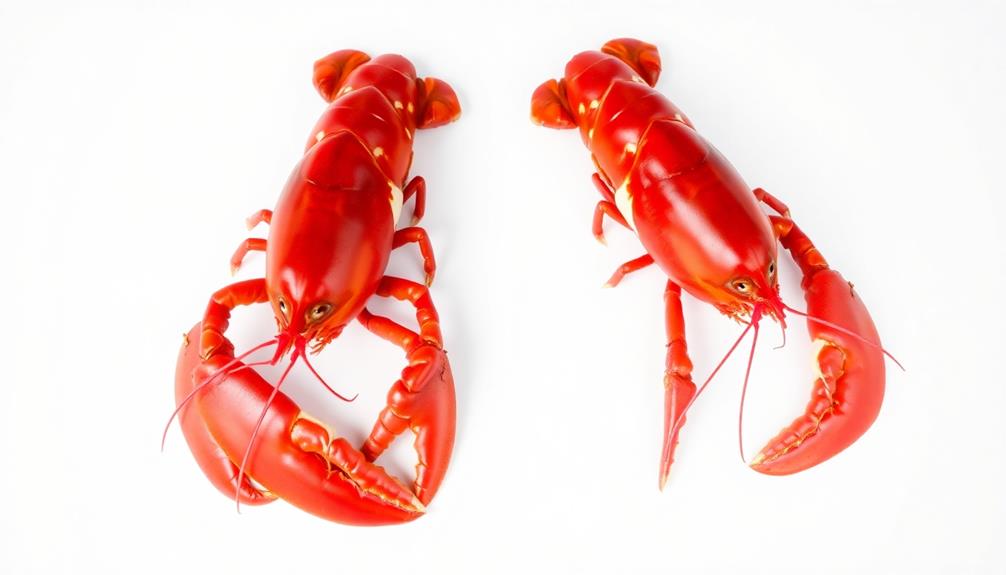
When purchasing live lobsters, it's crucial to inspect them thoroughly. Look for lobsters that are lively and energetic, with no signs of damage or discoloration. Healthy lobsters will have a firm, resilient shell and strong, pinched claws. Avoid any that appear sluggish or have missing legs or antennae.
Once you've found the perfect specimens, gently place them in a perforated bag or container to ensure they've ample air circulation. This will keep them alive and well until you're ready to cook them. Remember, the fresher the lobster, the better the flavor and texture will be.
When you get home, you'll want to store the lobsters in the coldest part of your refrigerator, preferably on a bed of damp newspaper or seaweed. This will help maintain their ideal temperature and humidity levels.
With a little care and attention, your live lobsters will stay lively and ready to enjoy at their absolute best.
Step 2. Crack Shell With Nutcracker

With your live lobsters ready, it's time to crack open their shells. Grab your trusty nutcracker and get ready to dig in! Gently grasp the lobster's body with one hand, and use the nutcracker to break through the hard shell.
Don't be afraid to apply a little pressure – you need to crack that shell to get to the delicious meat inside.
Once you've cracked the shell, use your fingers to pry it open. Carefully remove the meat from the claws and tail. Be sure to check for any small pieces of shell that might've broken off – you don't want to accidentally swallow those!
As you eat, savor the sweet, tender flavor of the fresh lobster. Dip the meat in melted butter or your favorite sauce for an extra burst of flavor.
With each bite, you'll be transported to a seaside feast fit for a king. Enjoy every moment of this culinary adventure!
Step 3. Remove Meat From Shell
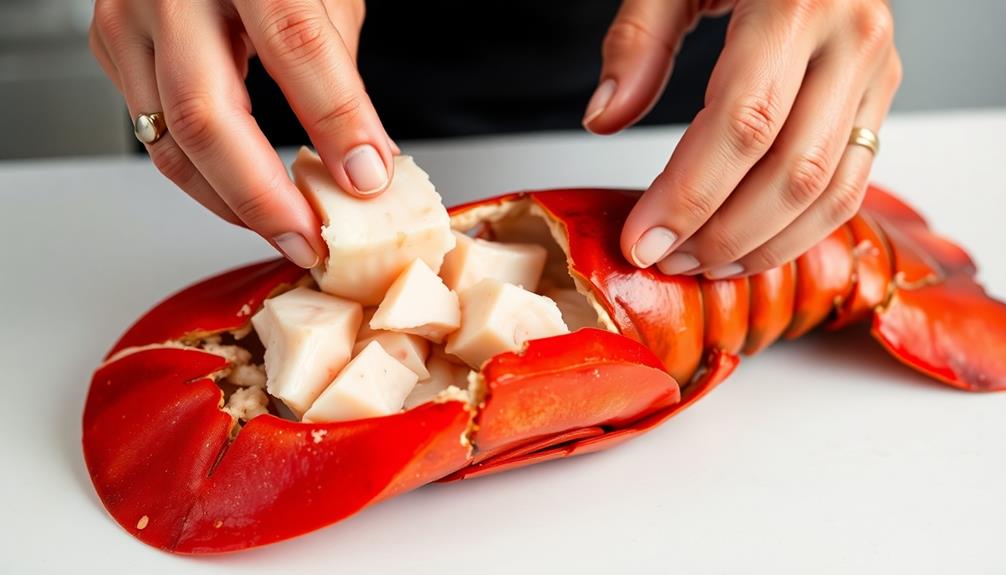
Once you've cracked the shell, use your fingers to carefully pry it open. The meat inside is the real treasure! Gently lift out the tender, juicy lobster meat. Don't be afraid to get a little messy – that's part of the fun.
Take your time and work slowly. Separate the claws from the body, then use your fingers to pull the meat from each section. The tail meat comes out in one long, succulent piece.
Savor the sweet, briny flavor as you enjoy this delicious seafood delicacy. Be sure to remove any remaining shell fragments. You don't want any unexpected crunch in your bite!
Rinse the meat under cool water to wash away any bits of shell. Now you're ready to enjoy your lobster however you like – dipped in melted butter, added to a salad, or simply on its own.
Step 4. Devein and Rinse Lobster Meat
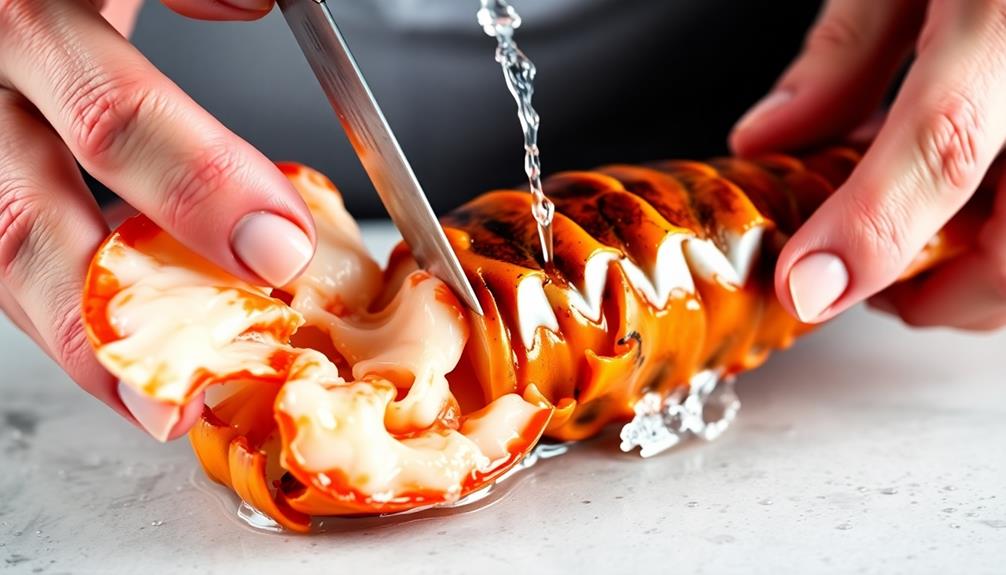
After separating the meat from the shell, the next step is to devein and rinse the lobster.
First, use a sharp paring knife to make a shallow cut down the center of the lobster meat. This will expose the dark vein, which is the digestive tract. Carefully pull out the vein and discard it. Don't worry if you can't remove the entire vein in one piece – just get as much as you can.
Next, rinse the lobster meat under cool running water. This will wash away any remaining debris or impurities. Be gentle and take your time – you don't want to break up the delicate meat.
Once the meat is clean, pat it dry with paper towels. With the deveining and rinsing complete, the lobster meat is now ready for the next step in the cooking process.
Prepare to impress your family and friends with your newfound lobster preparation skills!
Step 5. Cook Lobster Meat Thoroughly
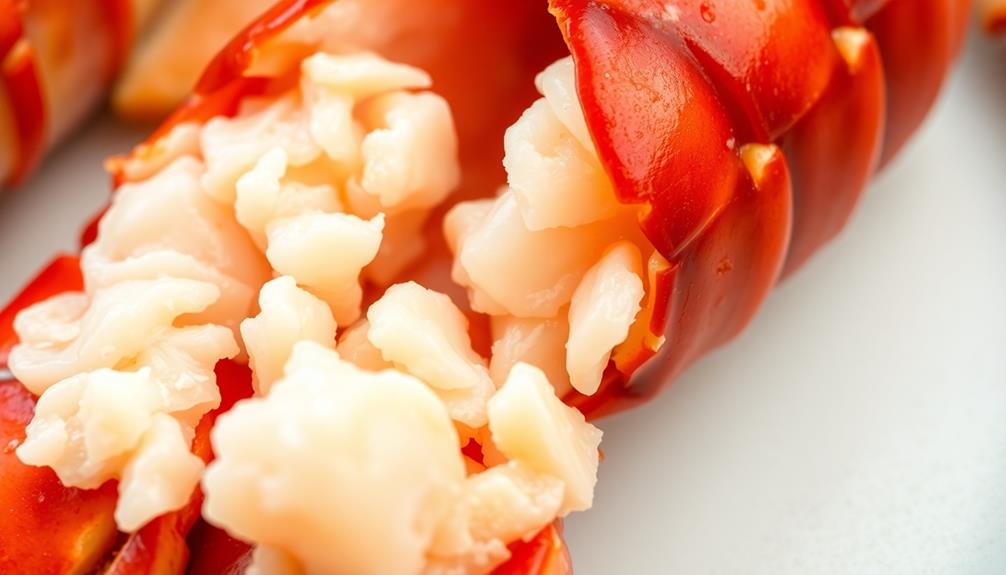
Properly cooking lobster meat is crucial to achieving a tender, flavorful result. Start by placing the meat in a steamer basket or pot with about an inch of water at the bottom. Bring the water to a boil, then cover and steam the lobster meat for 5-7 minutes. This gentle cooking method ensures the meat stays moist and doesn't become tough or rubbery.
Once the time is up, use tongs to remove the meat from the pot. Let it cool slightly, then use a fork to gently pull the meat away from the shell. Be careful not to overcook the lobster, as that can make it dry and chewy. The meat should be opaque and easily shred apart when done.
With perfectly cooked lobster meat, you're ready to enjoy this delicious crustacean in all sorts of dishes, from salads and pasta to decadent lobster rolls.
Savor the sweet, succulent flavor and tender texture of properly prepared lobster.
Final Thoughts
Lobster is a delicacy cherished by many, but it's important to approach its preparation with care and consideration.
Whether you're a seasoned lobster lover or trying it for the first time, the final steps are crucial to ensuring a delightful dining experience.
Once your lobster is cooked to perfection, the next step is to serve it with your favorite sides and dipping sauces. Some popular options include melted butter, lemon wedges, and garlic aioli. And if you’re feeling adventurous, consider searing scallops at home to add an extra dimension of flavor to your meal. Regardless of how you choose to enjoy your lobster, the final steps are essential in elevating your dining experience to a whole new level.
Once you've cooked the lobster meat thoroughly, it's time to savor the fruits of your labor.
Serve the tender, succulent meat with your favorite accompaniments, such as drawn butter, lemon wedges, or a refreshing salad.
The rich, buttery flavor of the lobster will delight your taste buds and leave you craving more.
Frequently Asked Questions
How Long Do Cooked Lobster Tails Last in the Refrigerator?
Cooked lobster tails can last up to 3-4 days in the refrigerator when stored properly. Make sure to keep them in an airtight container and consume them within that timeframe for the best quality and safety.
Can I Freeze Uncooked Lobster Tails for Later Use?
Yes, you can freeze uncooked lobster tails for later use. Simply wrap them tightly in plastic or place them in an airtight container and freeze for up to 6 months. This will preserve their freshness and flavor.
What's the Best Way to Remove the Shell From a Cooked Lobster?
To remove the shell from a cooked lobster, start by cracking the claws. Then, use your fingers to gently peel away the tail and body shells. Be careful not to lose any of the sweet, tender meat.
Can I Substitute Imitation Lobster Meat in a Recipe?
Yes, you can substitute imitation lobster meat in a recipe, but the flavor and texture won't be the same as real lobster. It's a decent alternative if you're looking to save money or can't find fresh lobster.
How Do I Know When a Lobster Is Fresh and of Good Quality?
To know if a lobster is fresh and of good quality, look for a hard, shiny shell with intact claws. The tail should be curled tightly against the body, and the lobster should feel heavy for its size.
